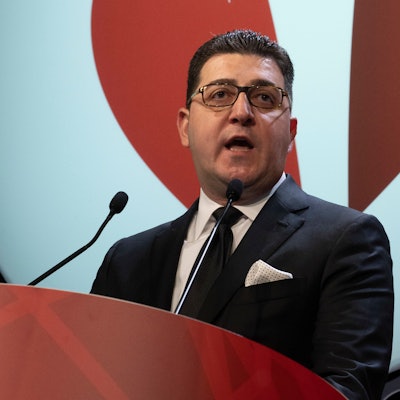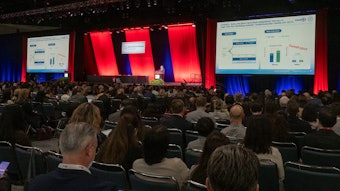2023 Late-Breaking Science: BEST-II, CATIS-2, ANGEL-ASPECT, SELECT 2, ARAMIS, RESCUE BT2 and CMOSS

Late-Breaking Science presented during the Friday #ISC23 Closing Main Event revealed:
- BP lowering after thrombectomy not harmful, benefits unclear.
- CATIS-2 finds no benefit from early BP lowering in acute ischemic stroke.
- Endovascular therapy is superior to medical management for acute ischemic stroke with a large infarct core.
- SELECT 2 shows clear benefit for thrombectomy for ischemic stroke with large infarct core without increased risk of bleeding or mortality.
- DAPT is not inferior to IV thrombolysis for mild, nondisabling stroke.
- RESCUE BT 2 shows tirofiban beats aspirin for some disabling strokes.
- Extracranial-intracranial bypass surgery no better than medical approach for stroke prevention.
No advantage to early BP lowering in acute ischemic stroke
Giving antihypertensive therapy during the early acute phase of ischemic stroke does affect the odds of death or major disability at 90 days compared to delayed antihypertensive therapy. The China Antihypertensive Trial in Acute Ischemic Stroke II (CATIS-2) compared the effects of antihypertensive treatment during the first 48 hours following onset of symptoms versus antihypertensive treatment beginning eight days after onset of symptoms on a composite outcome of death and major disability, defined as modified Rankin Scale (mRS) ≥3 at 90 days.
 Liping Liu, MD, PhD
Liping Liu, MD, PhD
CATIS-2 randomized 4,810 acute ischemic stroke patients to antihypertensive treatment within 48 hours of onset (2,408 patients) or to delayed treatment starting eight days after onset (2,394 patients) from 106 centers across China. The median age was 63.7 years, 65.0% were male, and 79.7% had a history of hypertension. The mean blood pressure (BP) at baseline was 163/92 mmHg. Antihypertensive treatment goals were a 10%-20% reduction in the early treatment group and <140/90 mmHg in the delayed treatment group.
The early treatment group showed a reduction in BP at seven days to 139/80 mmHg versus 151/86 mmHg for the delayed treatment group, Dr. Liu reported. But there was no difference in the primary outcome between the two groups at 90 days. Dr. Liu reported 12.0% in the early group versus 10.5% in the delayed group, risk ratio =1.17, p=0.092. The common odds ratio for the major secondary outcome, a shift in mRS at 90 days, was 1.05.
“There is no difference in 90-day outcomes between the two arms, which indicates we probably don’t need to reduce blood pressure early,” Dr. Liu said. “In practice, there are other specifics like intravenous tPA or other treatments that already address blood pressure, and autoregulation seems to reduce acute blood pressure even if you don’t treat it directly. We will follow patients longer for recurrent stroke, and there are specified subgroup analyses by age, gender, systolic BP at baseline, stroke severity and other factors. We believe further research is warranted.”
Endovascular therapy better than medical management for ischemic stroke with large infarct core
New trial data show an outcomes advantage for endovascular therapy (EVT) over medical management for patients with an ischemic stroke with a large infarct core treated within 24 hours from symptom onset. The ANGEL-ASPECT trial found an odds ratio of 1.37 (p=0.004) favoring EVT plus medical management for a more favorable modified Rankin Scale (mRS) shift at 90 days compared to medical management alone. There was increased bleeding in the EVT arm and a nonsignificant increase in intracranial hemorrhage within 48 hours, 6.1% versus 2.7%, p=0.12.
 Xiaochuan Huo, MD, PhD
Xiaochuan Huo, MD, PhD
ANGEL-ASPECT randomized 456 acute stroke patients who had either an ASPECT score of 3-5 or an infarct volume of 70-100 mL within 24 hours of onset of symptoms to EVT plus medical management (231 patients) or medical management alone (225 patients). EVT included mechanical thrombectomy, aspiration thrombectomy, intra-arterial thrombolysis, angioplasty or stenting. Best medical management was guideline-based at the treating clinician’s discretion. The primary outcome was shift in mRS at 90 days and the primary safety assessment by intracranial hemorrhage within 48 hours.
Patients treated with EVT showed better functioning at 90 days as measured by mRS, Dr. Huo reported. And although there was a numerical increase in bleeding events in the EVT group if any intracranial hemorrhage within 48 hours, 49.1% versus 17.3%, the difference in any was not statistically significant.
“We would like to see these results confirmed in a larger, international trial,” Dr. Huo said. “And because guidelines currently address patients with ASPECT scores of 6 or higher, I think we will see guidelines changing to include lower ASPECT scores based on this and other trials.”
Large core thrombectomy trial stopped early for efficacy
The SELECT 2 randomized trial of endovascular thrombectomy (EVT) in patients with large ischemic strokes was stopped early due to evidence of safety and efficacy. The multicenter randomized trial planned to randomize 560 patients with acute ischemic strokes within 24 hours of last known well with large ischemic cores on non-contrast CT, perfusion imaging or magnetic resonance imaging to EVT or best medical therapy. The data safety monitoring board halted the trial after the first 300 patients had been evaluated 90 days post-treatment. Patients in the EVT arm showed statistically and clinically significant improvement in functional outcome, functional independence and independent ambulation as measured by shift in modified Rankin Scale (mRS) scores without significant increases in symptomatic intracranial hemorrhage (sICH) or mortality.
 Amrou Sarraj, MD, FAHA
Amrou Sarraj, MD, FAHA
SELECT 2 randomized a total of 352 patients at 29 centers in Australia, Europe, New Zealand and North America to EVT plus best medical management or best medical management alone before it was halted. All patients had a proximal occlusion to the internal carotid artery or the first segment of the middle cerebral artery with a large ischemic core on imaging. EVT used retrievers, aspiration devices or a combination thereof as approved by local regulatory authorities. Some patients had also received intravenous thrombolysis before randomization.
Patients in the EVT arm had a significant improvement in mRS for functional outcome versus medical management, WMW probability of superiority=0.60 (95% CI, 0.55 to 0.65), Gen OR=1.51 (95% CI, 1.20 to 1.89; p<0.001. Improvements were also seen in functional independence (RR, 2.97; 95%CI, 1.60 to 5.51) and independent ambulation (RR, 2.06; 95%CI, 1.43 to 2.96)). There were no significant differences in SICH (RR, 0.49; 95%CI, 0.04 to 5.36) or mortality (RR, 0.91; 95%CI, 0.71 to 1.18).
“These results will change systems of care for a significant number of patients with large ischemic strokes who are currently not treated with thrombectomy and not transferred to higher level stroke centers for care,” Dr. Sarraj said.
Results of SELECT 2 were published simultaneously in the New England Journal of Medicine.
DAPT noninferior to thrombolysis in mild, nondisabling stroke
The first head-to-head comparison of dual antiplatelet therapy (DAPT) versus intravenous thrombolysis (IVT) in mild acute ischemic stroke found that DAPT is not inferior to alteplase. The randomized, multicenter, open label Antiplatelet Versus Alteplase in Acute Mild Ischemic Stroke (ARAMIS) trial found similarly excellent functional outcomes, a modified Rankin Scale (mRS) of 0 or 1 at 90 days, 93.8% in the DAPT arm and 91.4% in the alteplase arm (p=0.0002 for noninferiority).
Bleeding outcomes at 90 days were numerically better in the DAPT arm, 0.3% symptomatic intracerebral hemorrhage versus 0.9% in the alteplase arm. A total of 1.6% of patients on DAPT had any bleeding event versus 5.4% of alteplase patients.
ARAMIS compared clopidogrel plus aspirin (369 patients) versus IV alteplase (350 patients) allocated in each arm in individuals with NIHSS score ≤5 with ≤1 single item score in vision, language, neglect or single limb weakness and 0 consciousness score at randomization. All patients began treatment within 4.5 hours of known onset of symptoms. Patients were enrolled at 38 centers in China between October 2018 and April 2020.
Tirofiban superior to aspirin for disabling stroke without large, medium size vessel occlusion
Tirofiban, a glycoprotein IIb/IIIa receptor inhibitor used to treat acute coronary syndromes, is potentially effective for patients with disabling acute ischemic stroke who do not have large or medium size vessel occlusion. Results of the RESCUE BT 2 trial suggest a potential treatment for the majority of acute ischemic stroke patients who are ineligible for reperfusion therapy using either intravenous thrombolysis (IVT) or endovascular thrombectomy (EVT) or who do not improve following reperfusion. Currently available therapy for these patients is suboptimal, and there is a critical need to explore alternative or supplemental therapy strategies.
“We focused on four groups of acute ischemic stroke patients for whom there is no recommended treatment,” said Wenjie Zi, MD, executive chief of neurology at Xinqiao Hospital and The Second Affiliated Hospital, Army Medical University (Third Military Medical University) in Chongqing, China. “Patients had an ischemic stroke within 24 hours but are ineligible for IVT or EVT, progressive stroke symptoms between 24 and 96 hours showed neurological deterioration after receiving IVT or had IVT but showed no improvement.”
The double-blind, double-dummy trial randomized 1,177 patients, 606 patients to IV tirofiban plus oral placebo and 571 patients to oral aspirin and IV placebo at approximately 100 sites across China. All patients had a disabling ischemic stroke with NIHSS score ≥5 and NIHSS motor item score of 2-4. None had any visible cerebral arterial occlusions by CT angiography, MR angiography, or digital subtraction angiography. The primary outcome was a score of 0-1 on the modified Rankin Scale (mRS) at 90 days. Primary safety outcomes included death and symptomatic intracranial hemorrhage (sICH).
More tirofiban patients met the primary outcome than aspirin patients, 29.1% versus 22.2%, with an adjusted risk ratio of 1.26 (CI=1.04-1.53, p=0.02). There was no significant difference in mortality, 3.8% for tirofiban versus 2.7% for aspirin, RR=1.62 (CI=0.88-2.95, p=0.12). The tirofiban group had a higher incidence of sICH, 1.0% versus 0.0% (p=0.03).
No advantage for extracranial-Intracranial bypass surgery for stroke prevention in Asian population
The largest trial of extracranial-intracranial bypass surgery (EC-IC) in Asian population failed to show a statistically significant benefit versus best medical management. Results of the CMOSS trial in China mirror results of North American trials of EC-IC bypass that underrepresented Asian populations.
“Stroke is the leading cause of death in China, with an annual incidence between 10% and 27% in Asian populations,” said Tao Wang, MD, attending neurosurgeon at Xuanwu Hospital, Capital Medical University in Beijing. “The primary cause of ischemic stroke is atherosclerotic disease in the carotid and intracranial arteries, which is nearly five times more prevalent in Asian populations than in North American populations. Earlier EC-IC bypass trials focused on the internal carotid artery (ICA) while middle cerebral artery (MCA) occlusion had not been studied. There remains a significant unmet need to prevent stroke and reduce stroke burden globally and most especially in Asian populations.”
CMOSS randomized 324 patients presenting with transient ischemic attack (TIA) or nondisabling ischemic stroke within the past 12 months at 13 high-volume stroke centers in China to EC-IC bypass plus medical therapy (161 patients) or medical therapy alone (163 patients). All patients had either a unilateral occlusion to an ICA or MCA and misery perfusion, inadequate cerebral blood supply relative to metabolic demand, on CT perfusion imaging. The primary outcome was a composite of stroke or death within 30 days or ipsilateral ischemic stroke between 30 days and two years after treatment.
The primary outcome was numerically lower in the EC-IC bypass group, 8.6% versus 12.3%, relative risk 0.87 (95% CI 0.64-1.17, p=0.38) but the difference was not statistically significant, Dr. Wang reported. Secondary outcomes, including two-year stroke, fatal stroke and disabling stroke, showed similar trends. The risk of ipsilateral stroke ischemic stroke between 30 days and two years was 2.0% in the surgical group versus 10.3% for the medical group (p=0.003).
Subgroup analysis showed significantly better results for EC-IC bypass in patients with BMI of 24-28 and those whose most recent ischemic event was >60 days before randomization. Patients with MCA occlusion and misery perfusion showed a numerical trend favoring surgery. No subgroup showed a benefit for medical therapy versus surgery.
“There is still a high incidence of recurrent stroke in symptomatic patients with ICA or MCA occlusion and EC-IC bypass has potential for certain populations,” Dr. Wang said. “Future studies focusing on these subgroups are warranted.”












